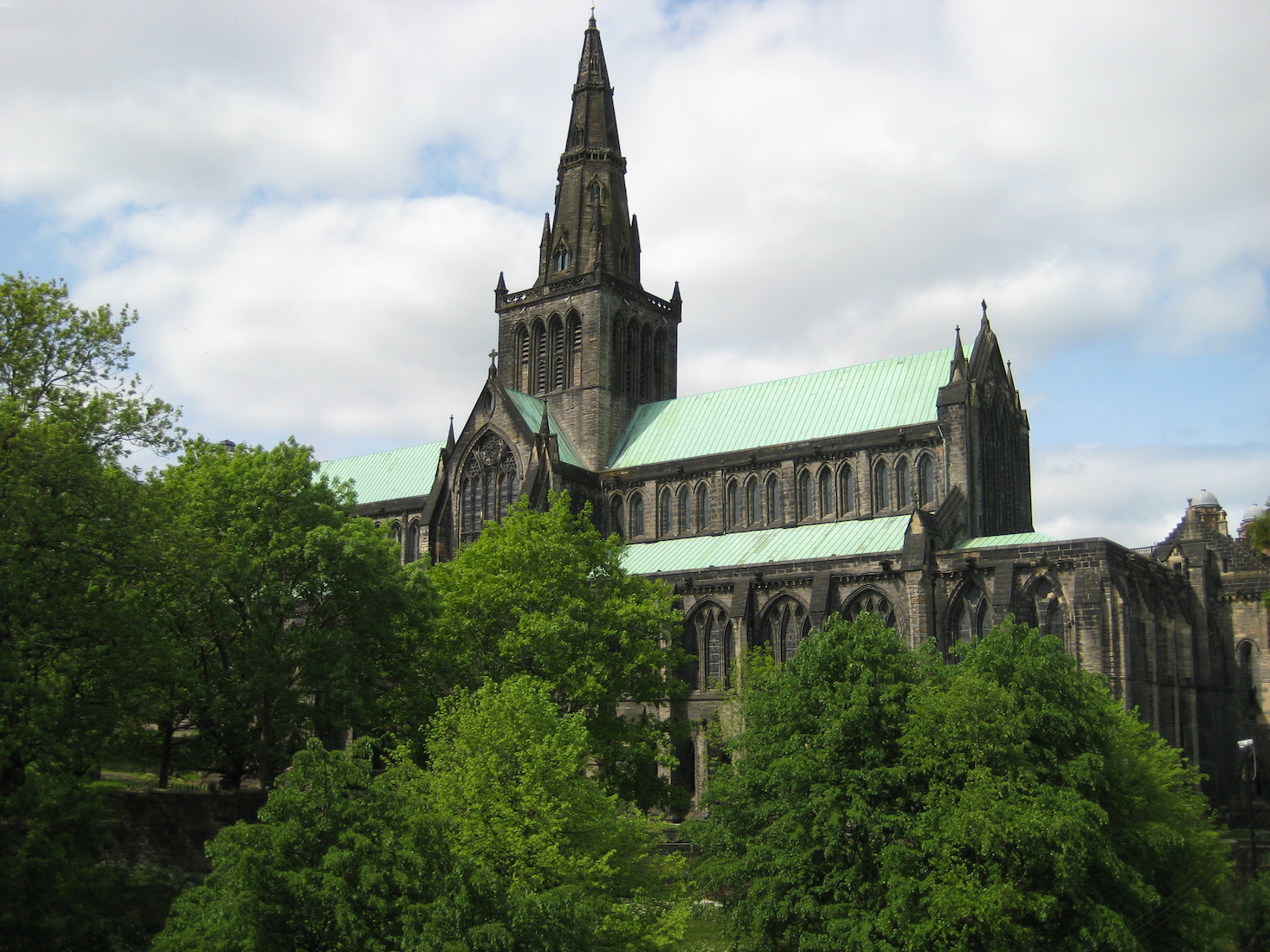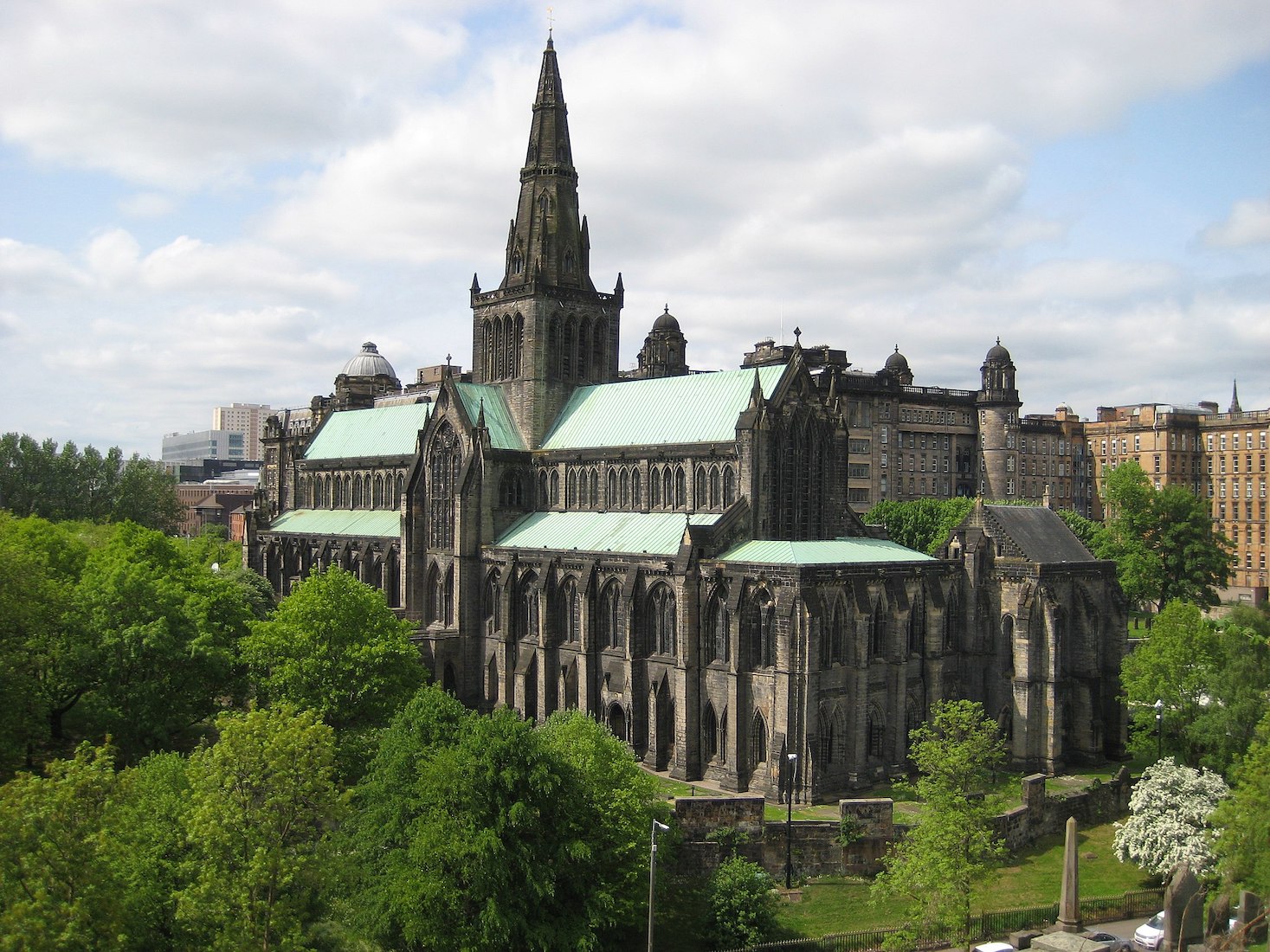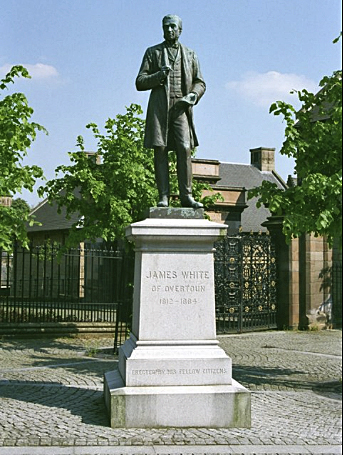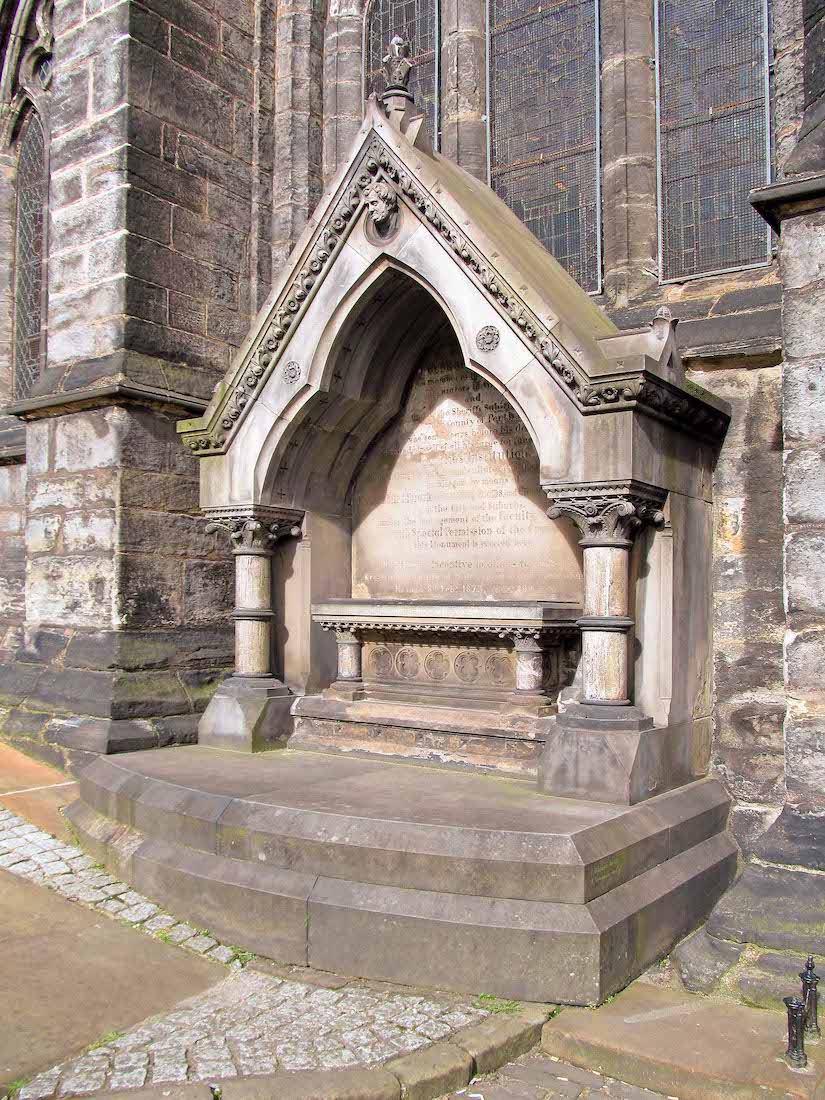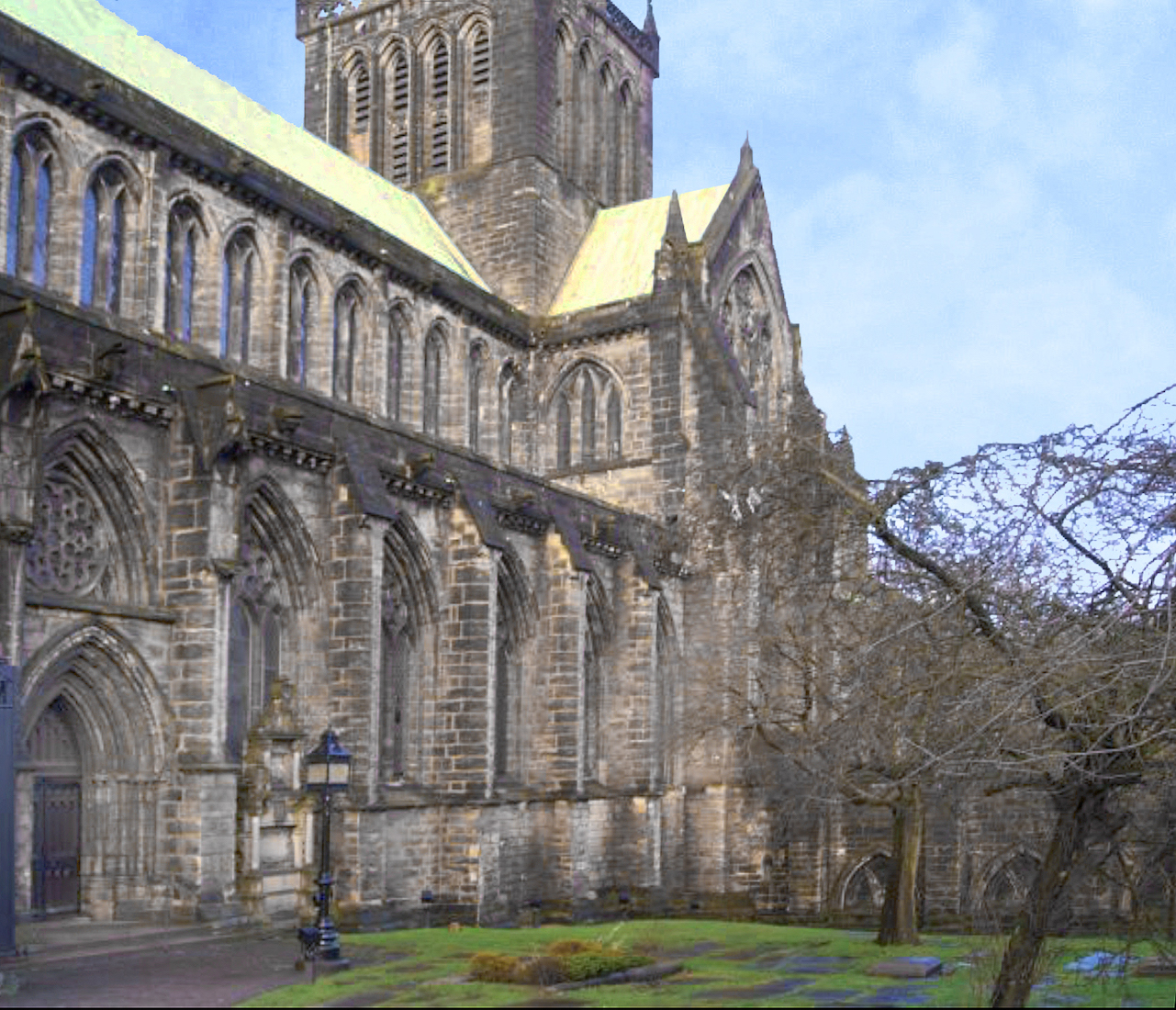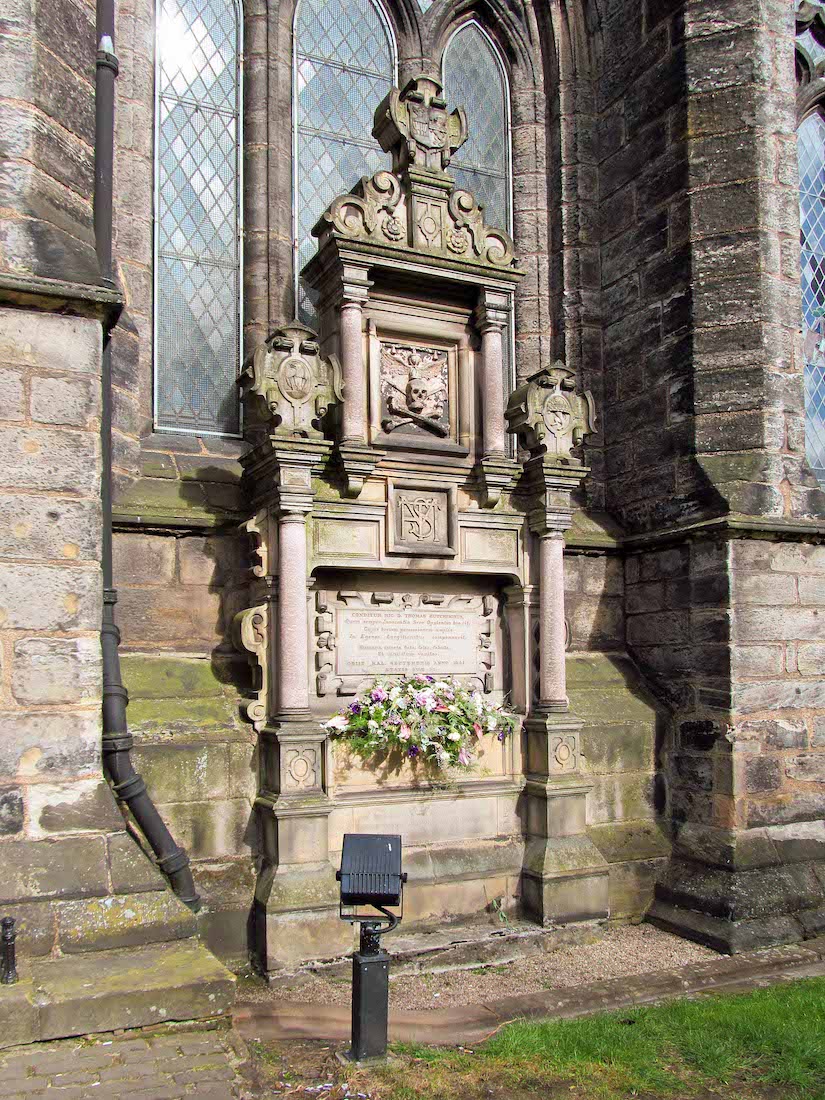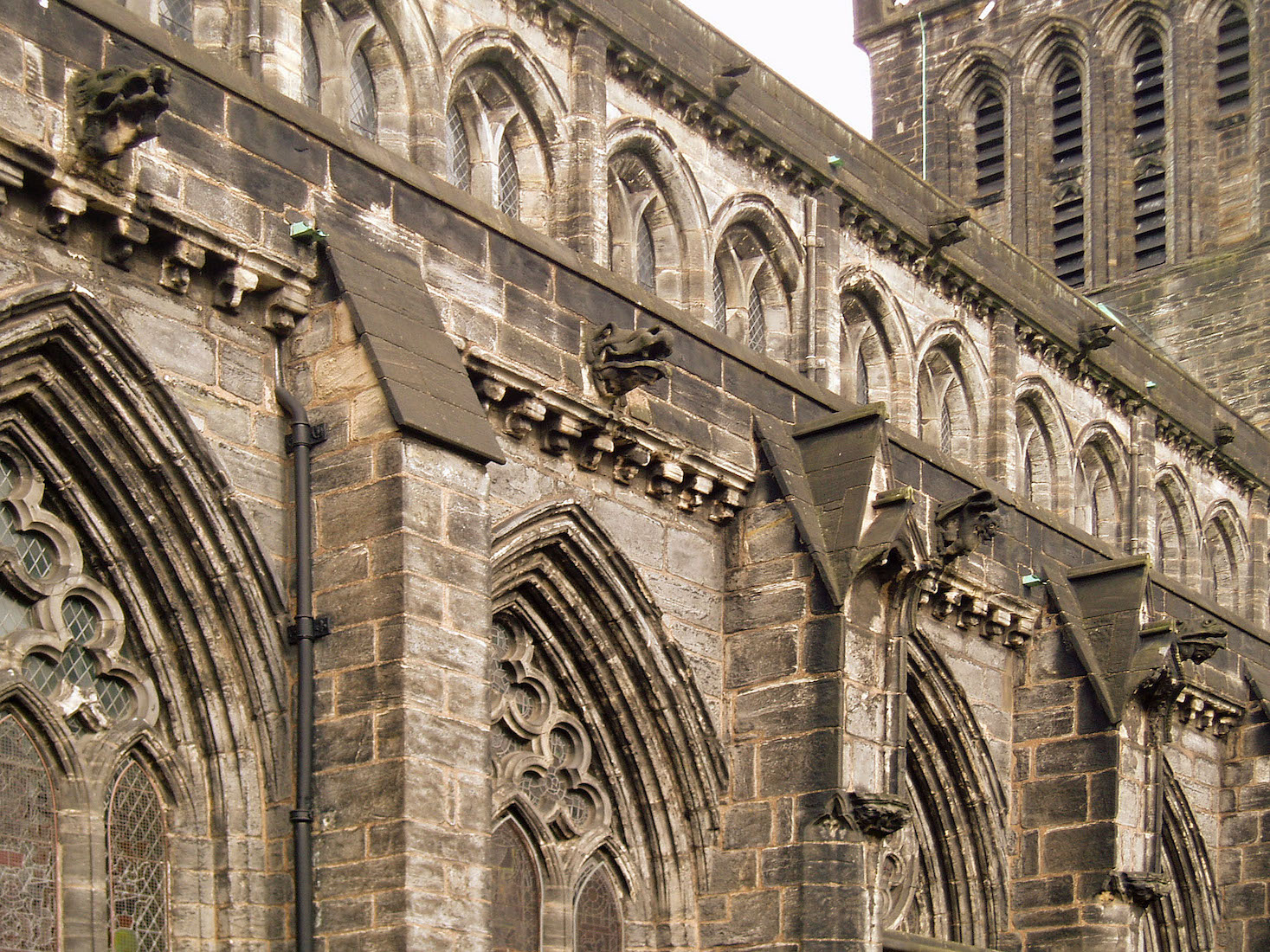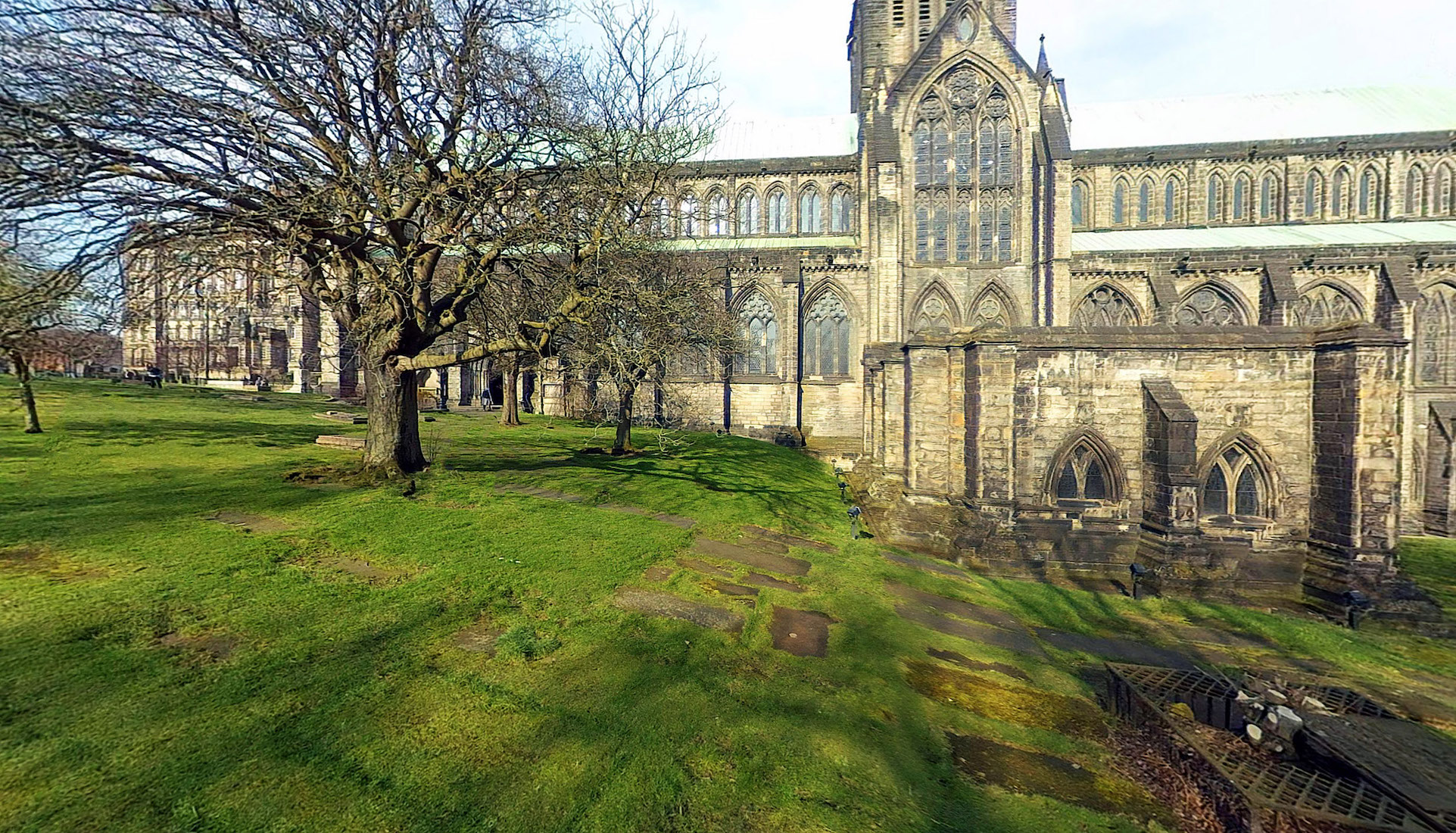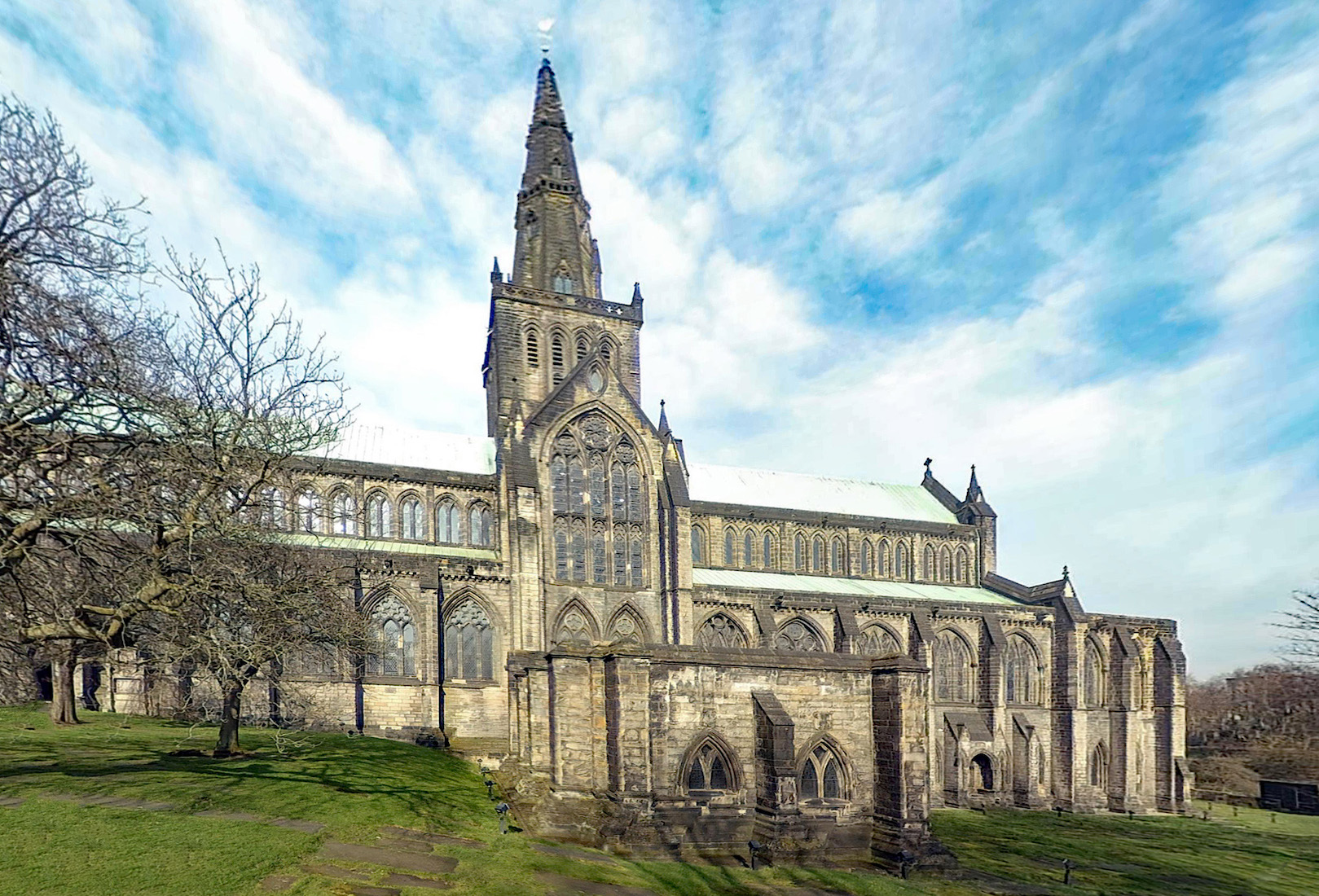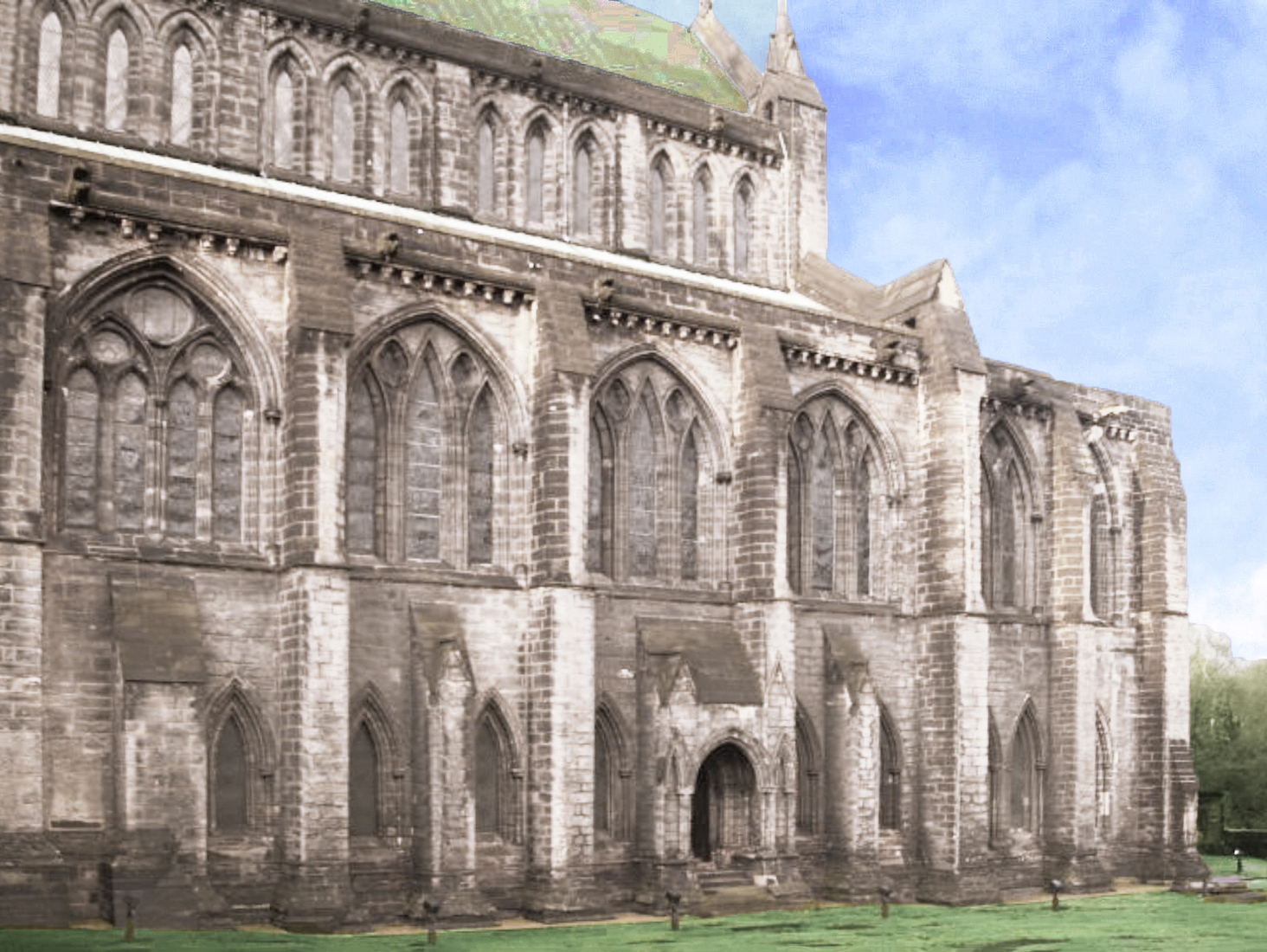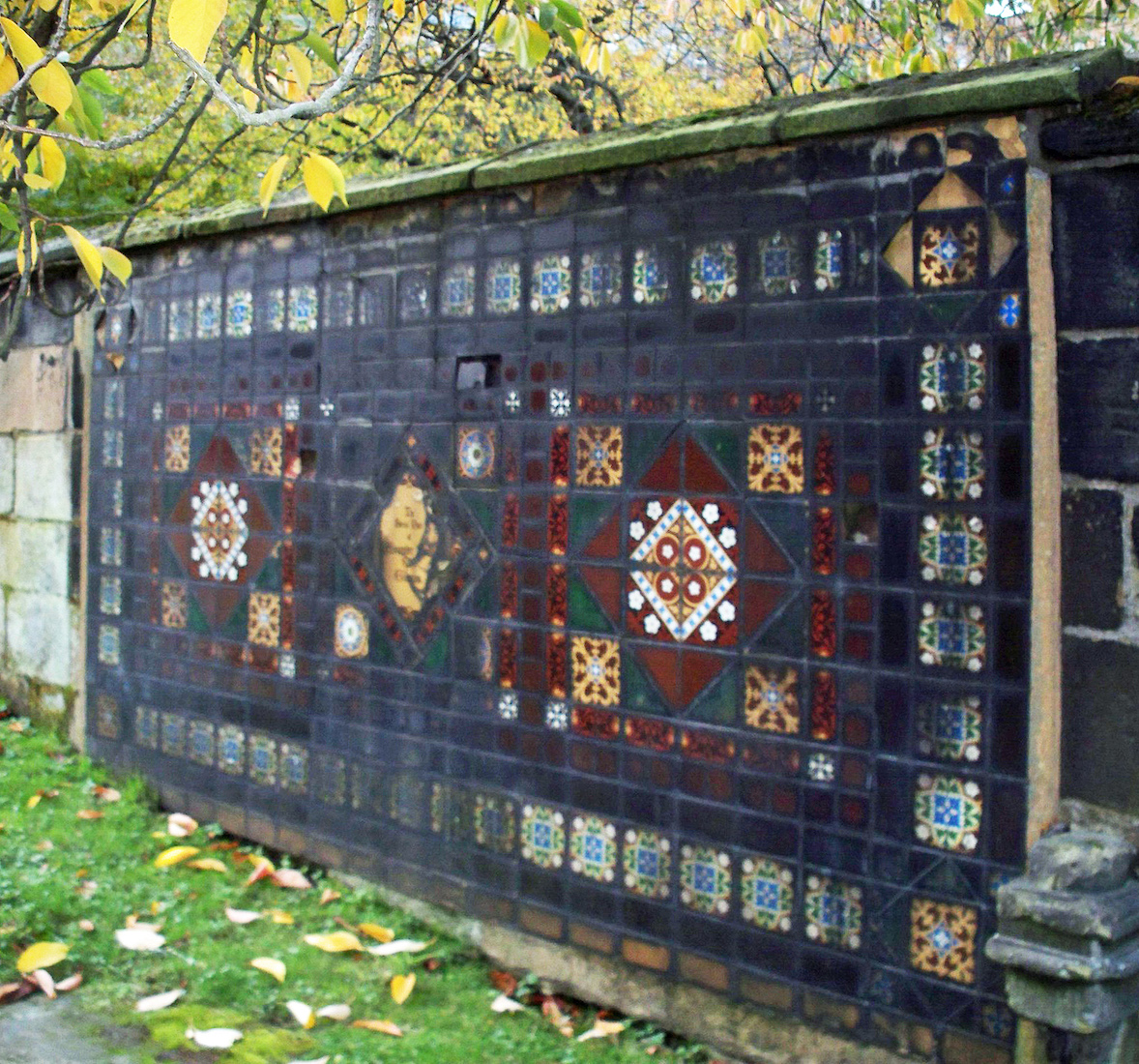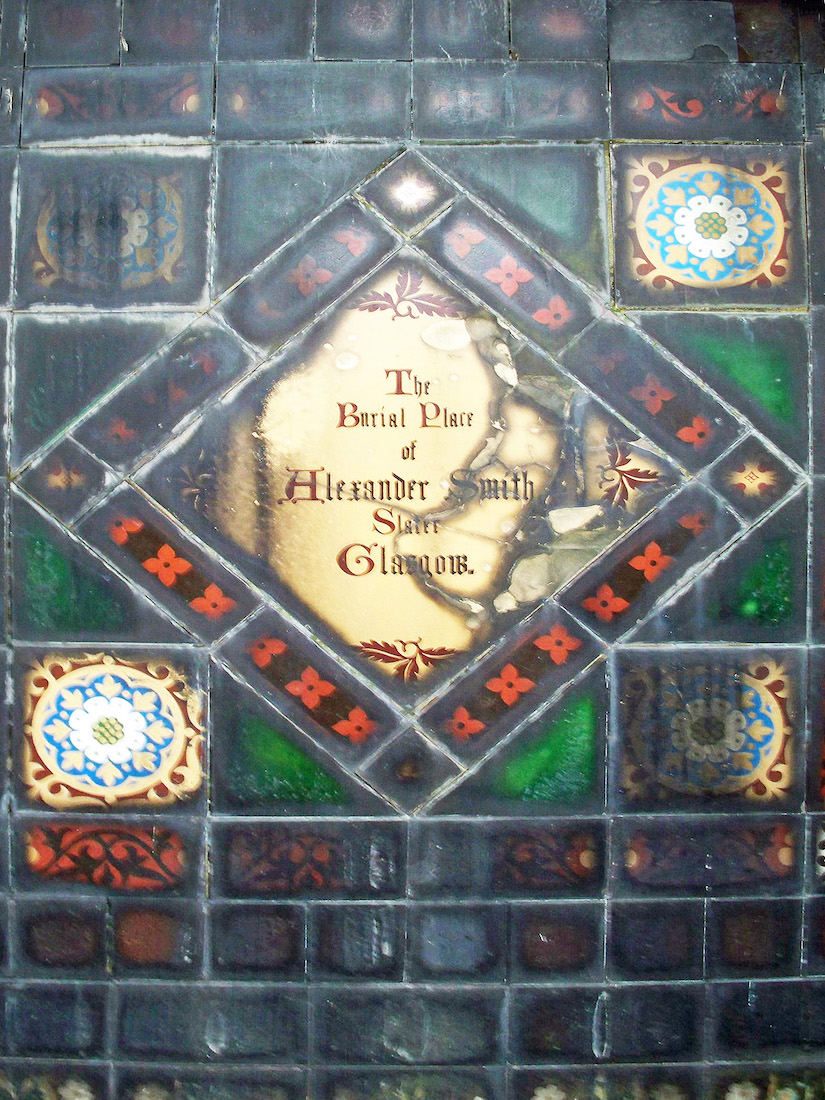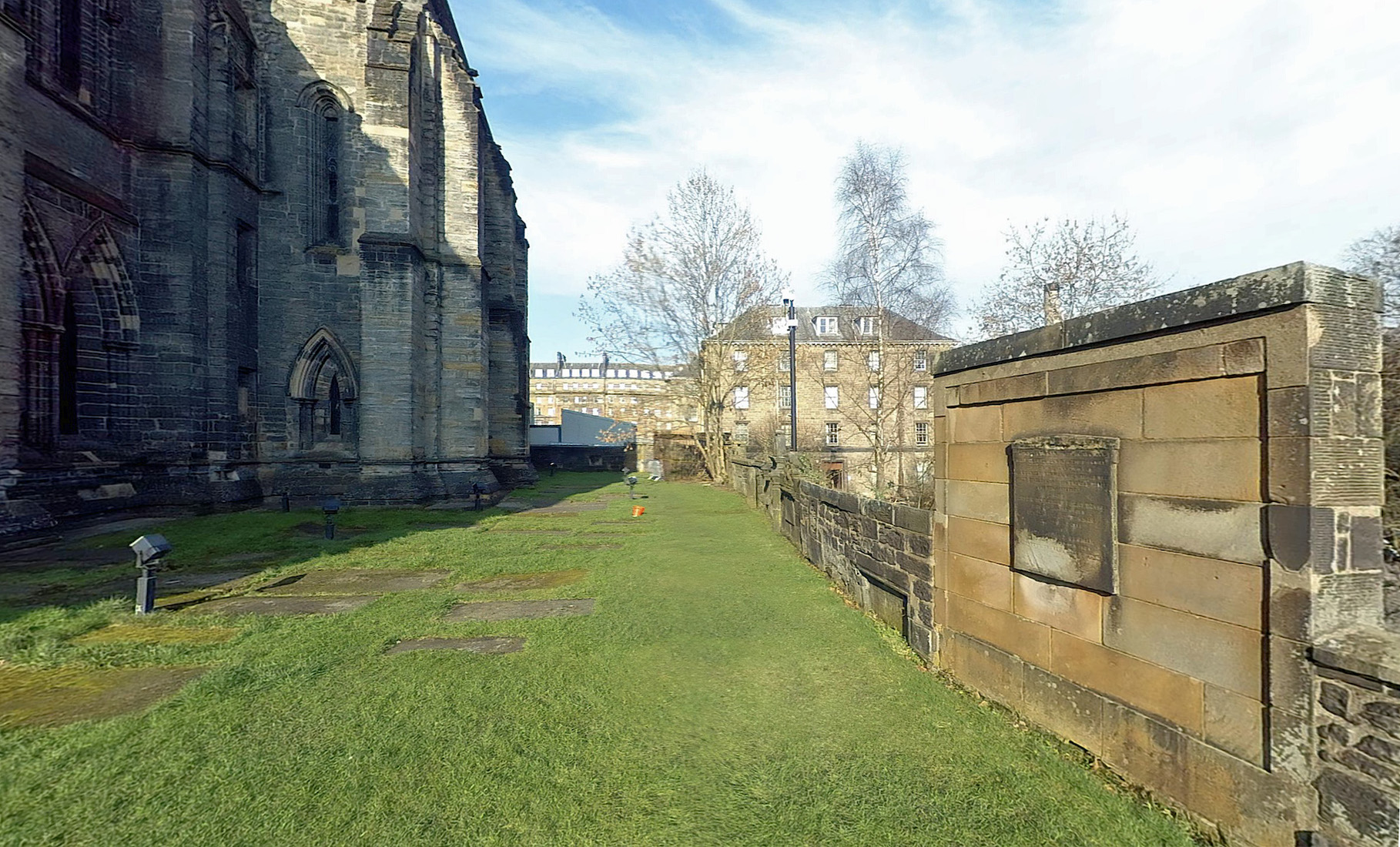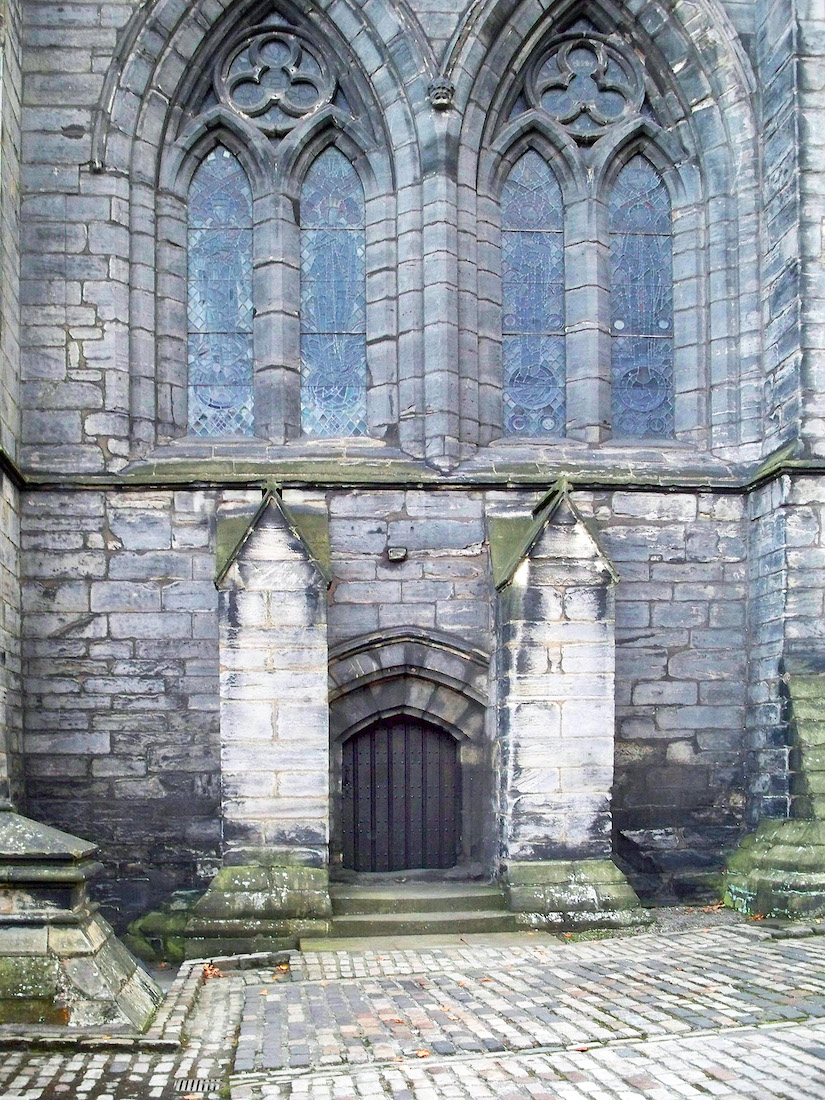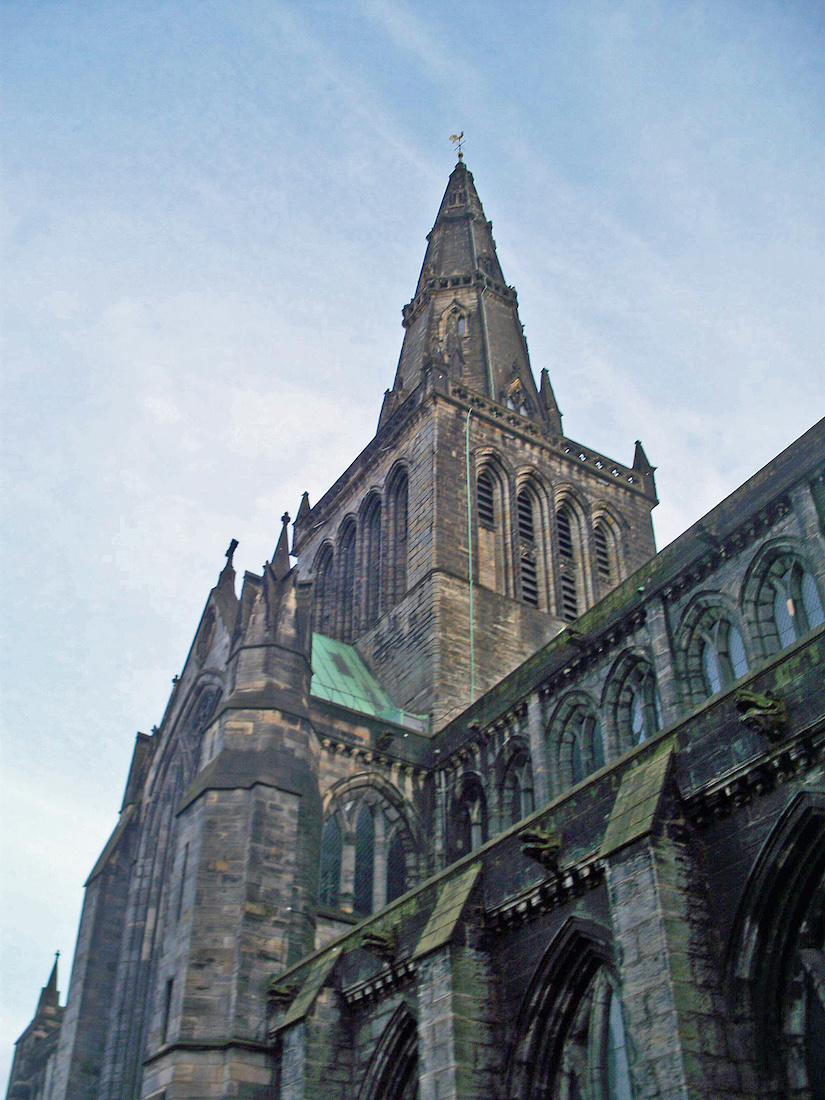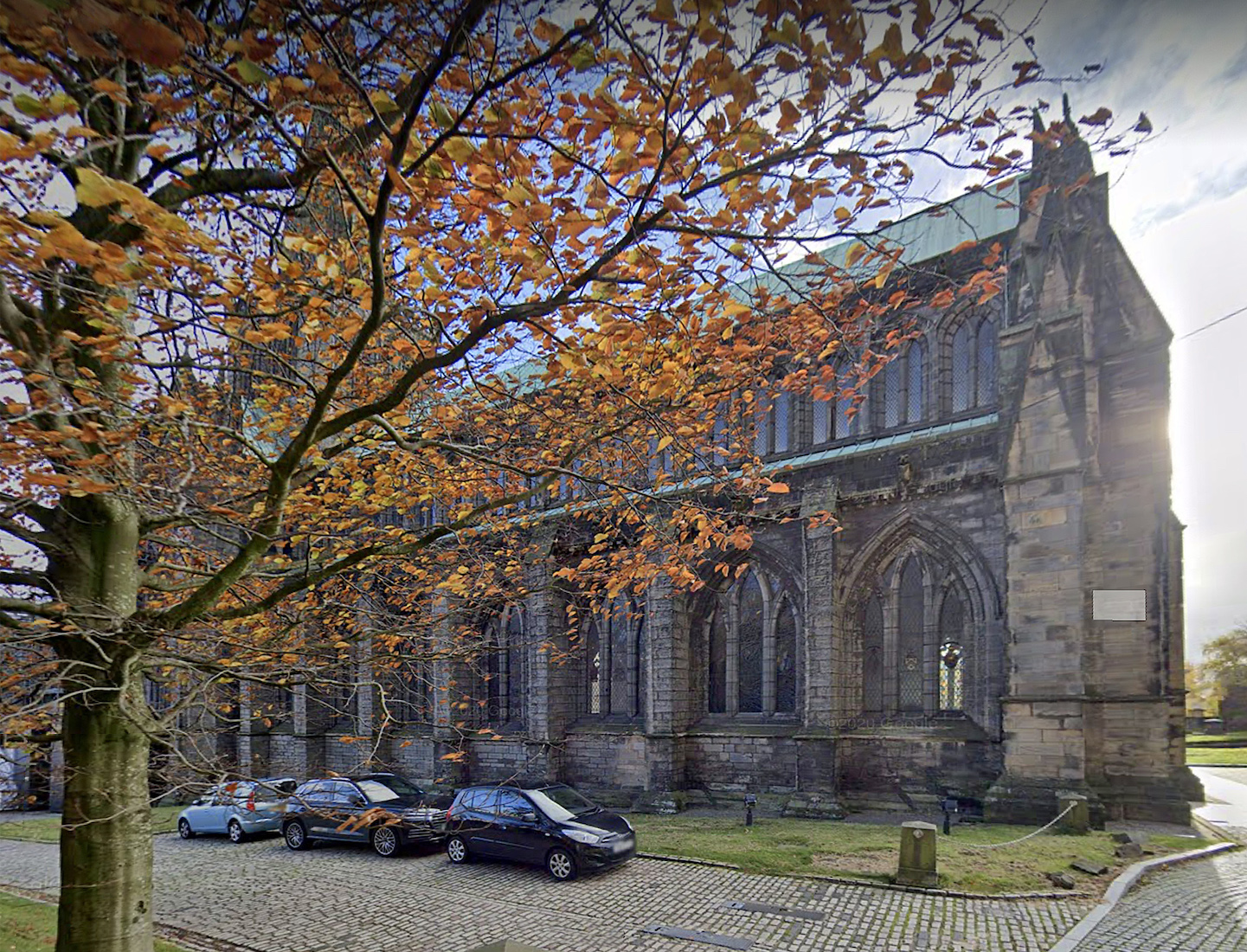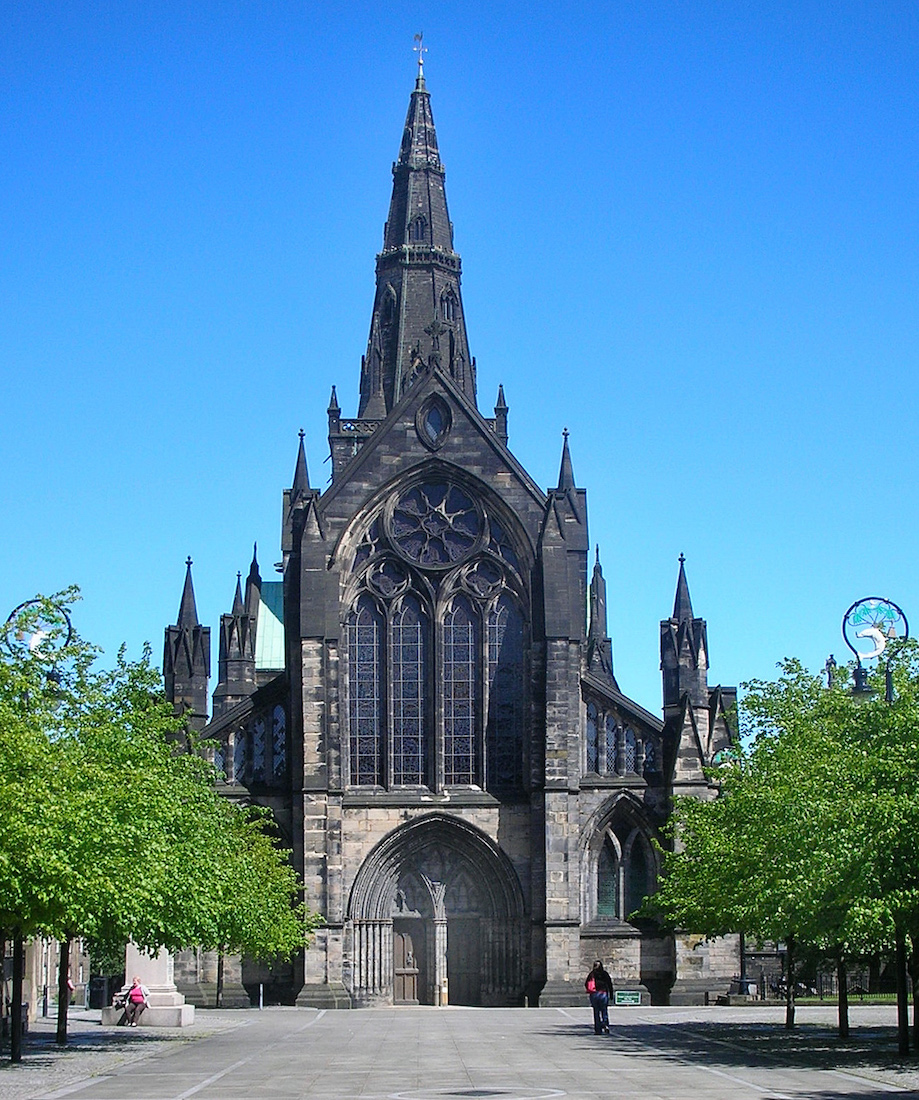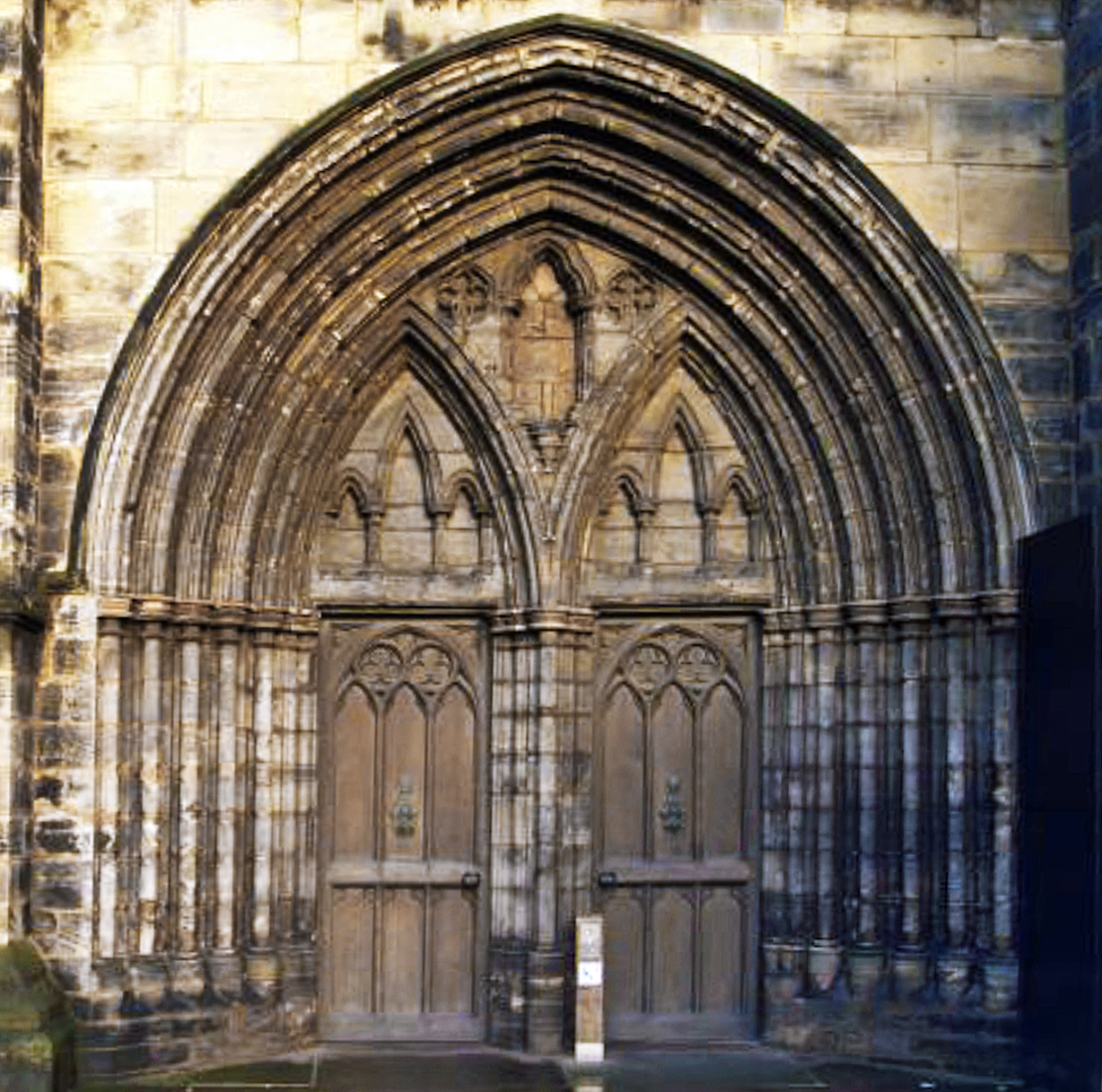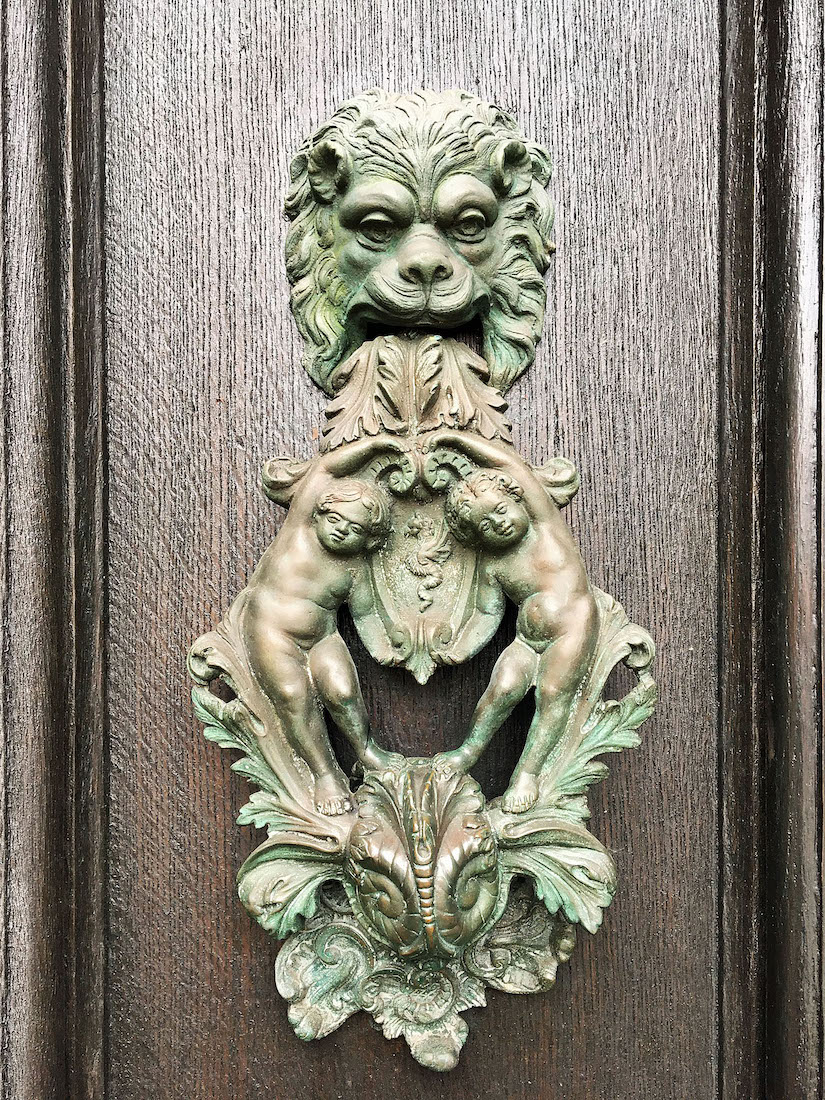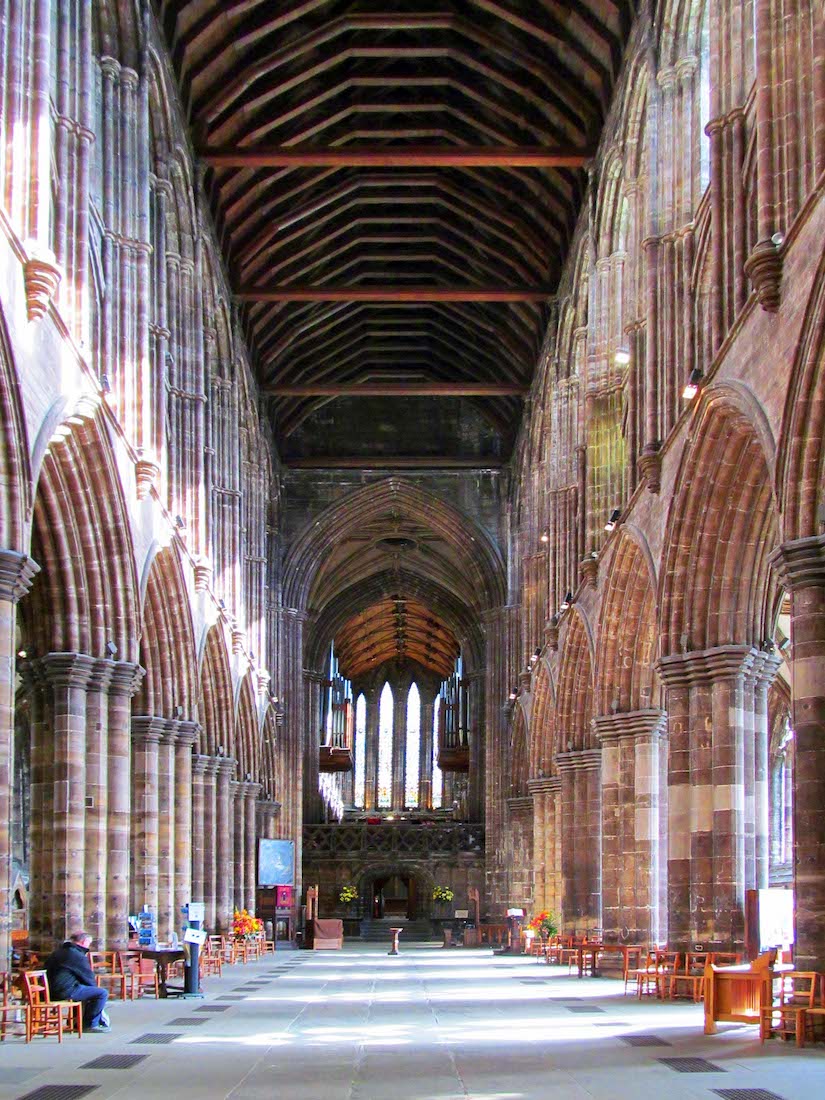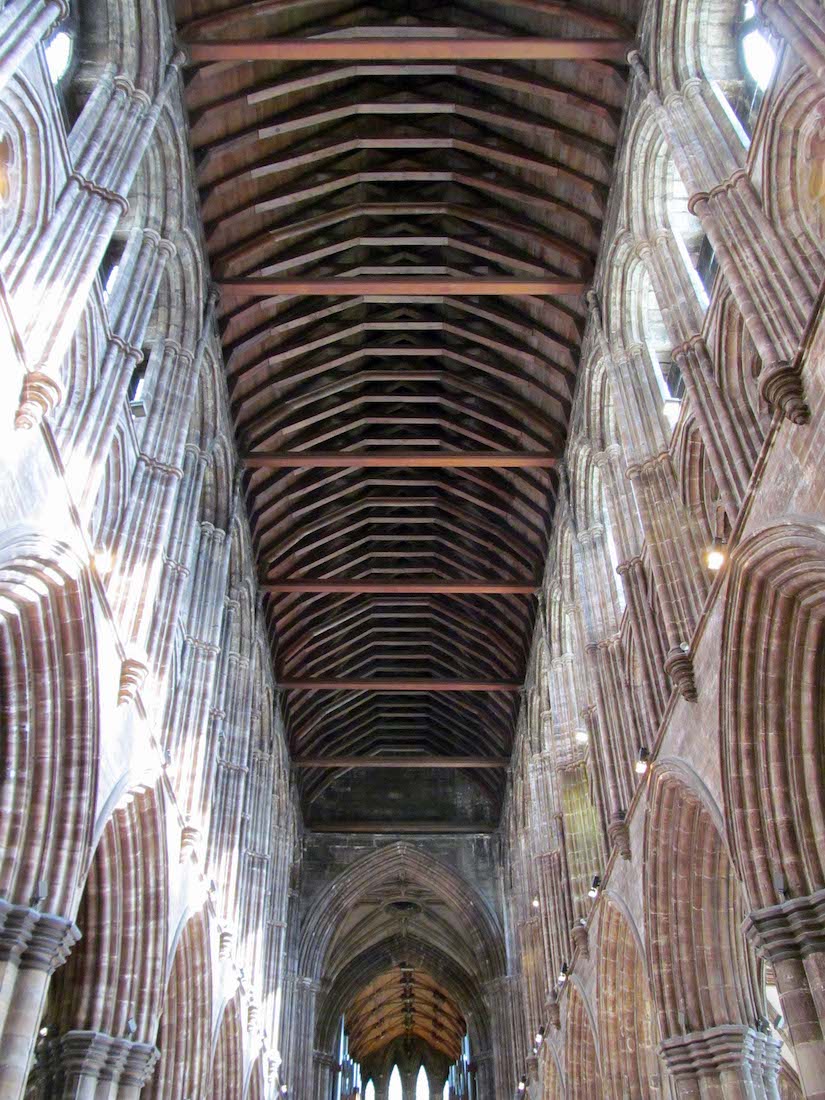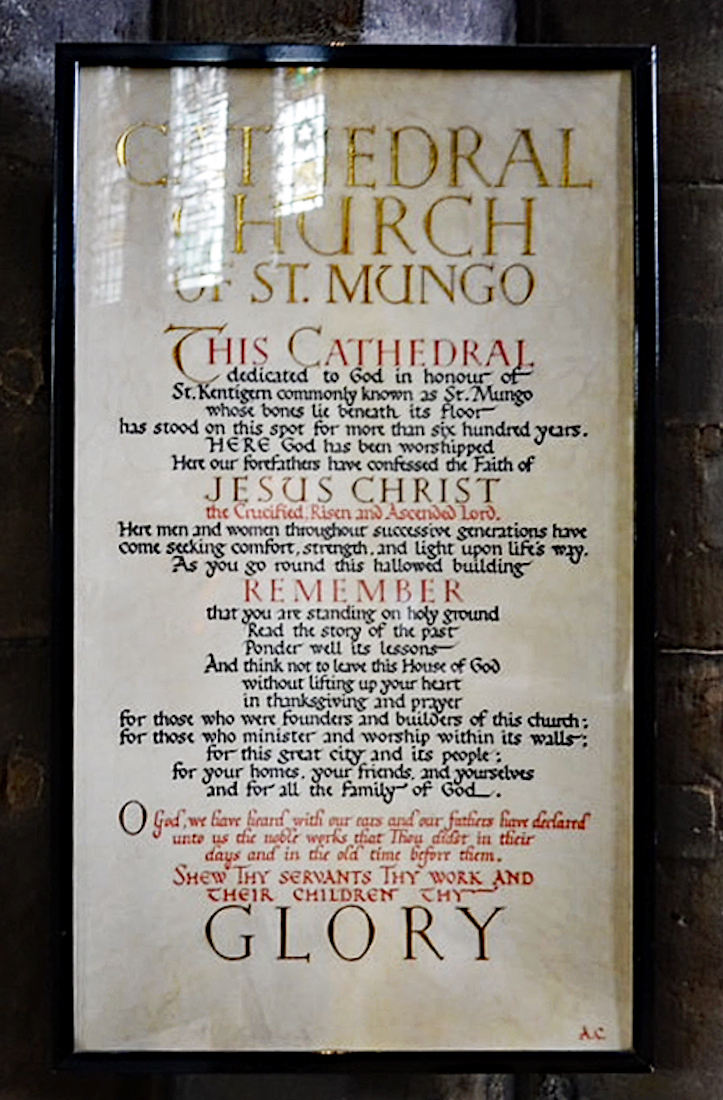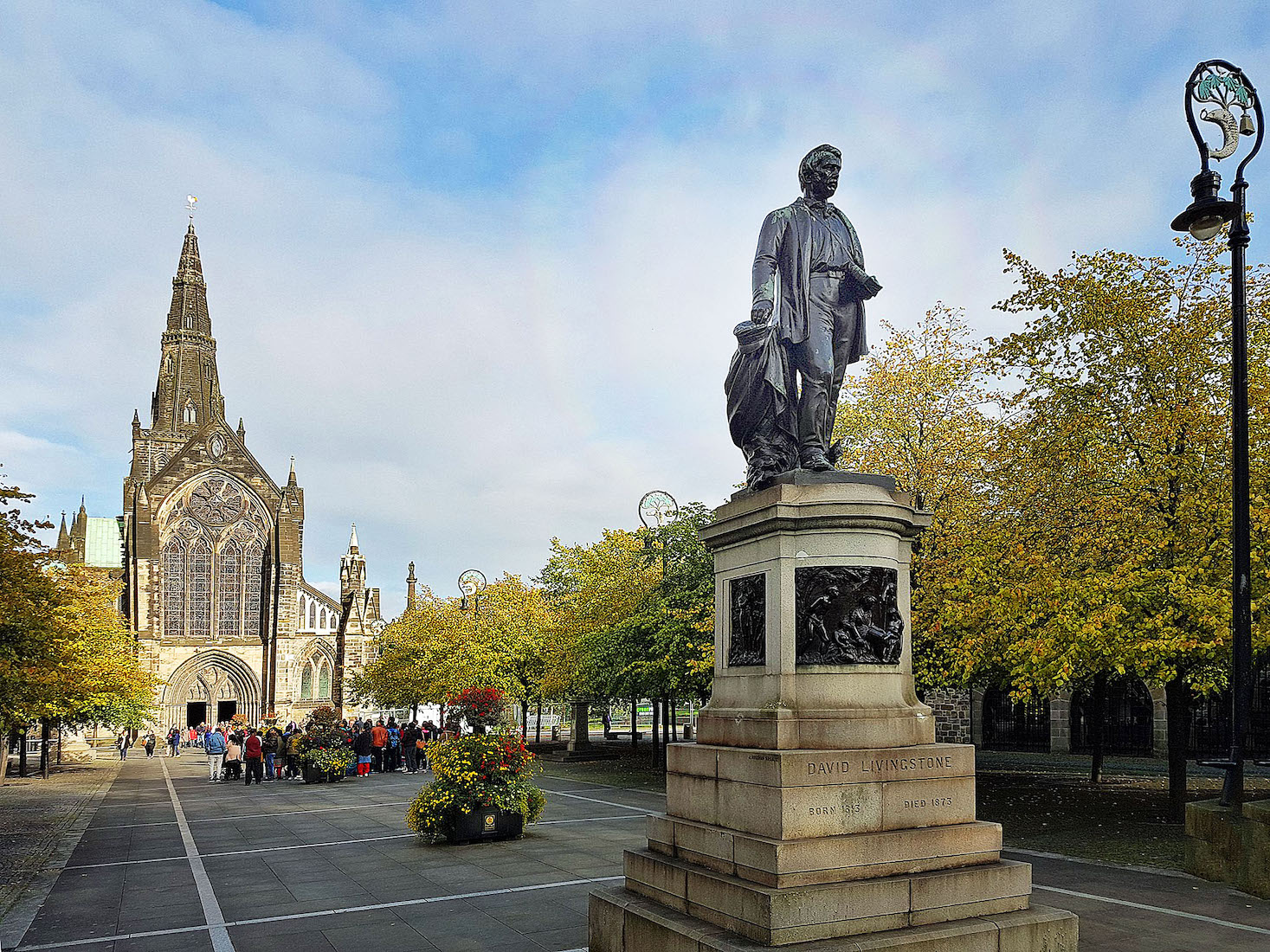
There are two approaches to the West doors of the Cathedral: this is the beautiful avenue parallel to the Cathedral Precinct. We are greeted by David Livingstone (1813 – 1873), who was a Scottish physician, Congregationalist, and pioneer Christian missionary with the London Missionary Society. He was also an explorer in Africa, and one of the most popular British heroes of the late 19th-century Victorian era. The buttresses alongside the West doors show signs of movement! [Photograph Credit: CCL Wikimedia: Singlehammer]
E2. MUSEUM VIEW W-PT

The more southerly approach to the Cathedral from Cathedral Square enters past the St Mungo Museum. From the Museum we see here the Cathedral in all its Gothic grandeur, and more distant, to the right, part of the large Glasgow Necropolis – the city cemetery, overlooking the Cathedral. In the foreground is a statue of James White, and next to this at extreme right, the entrance to Church Lane. [Photograph Credit: CCL Wikimedia:Paul Trafford]
E3. TOWER AND CHOIR W-PT
Church Lane follows along the boundary of the wooded Cathedral grounds, giving us beautiful views of the old building. The Cathedral is well known for its copper roof with its lovely mature green patina, acting as a landmark for miles around. [Photograph Credit: CCL Wikimedia: Paul Trafford]
E4. VIEW FROM THE NECROPOLIS W-PT
Following Church Lane we cross over busy Wishart Road, and come to the Necropolis. This is worth a visit in its own right, but we are here to enjoy the magnificent over-view of the Cathedral. Clearly visible here is the South transept, and the high clerestory windows along this side. We can also see how the ground has dropped away at this Eastern end, allowing for the large Lower Church. The Cathedral Quire links to the two storey Chapter House at right. And at centre is the impressive tower and spire. [Photograph Credit: CCL Wikimedia:Paul Trafford]
E5. JAMES WHITE STATUE W-LR
After taking our time to enjoy the Cathedral vista, we walk back along Church Lane to the James White statue. James White (1812–1884) was a Scottish lawyer, businessman and chemicals manufacturer. In 1890 he was honoured posthumously with this statue in Glasgow’s Cathedral Square, designed by John Mossman and sculpted by Frank Leslie. [Photograph Credit: CCL Wikimedia: Lairich Rig]
E6. BAILLIE MONUMENT WH
Our plan is now to take the path closer to the Cathedral and walk around it in a counter-clockwise direction. We come first to the George Baillie monument, near the South door. Baillie was one of Glasgow’s rich citizens who devoted his wealth to the establishment of public libraries. He died in 1873 in his 89th year.
E7. SOUTH DOOR AND WALL WH
The South door shown here at left is the main entrance for weekday visitors to the Cathedral. It has an interesting rose window above. We can see a further monument just to the left of the lamp.
E8. HUTCHESON MONUMENT WH
On the East side of the South door is another monument – this one a 17th century Scots Renaissance-style monument to Thomas Hutcheson. Hutcheson (1590 – 1641) was a philanthropic lawyer who bequeathed £1,000 for the rebuilding of the ruinous buildings at the Old College, and 2,000 marks to employ ‘ane bibliothecare [librarian]’. The librarian was to be appointed by the College authorities and ‘be the counsall of the burgh of Glasgow’ for a period of four years.
E9. SOUTH WALL DETAILS AMT
Medieval stone masons used blonde Glasgow stone to build the Cathedral. Later problems have been caused by weathering, and by pollution deposits formed during Glasgow’s more recent industrial past. A row of much weathered gargoyles can be seen along the top parapet.
E10. SOUTH WALL AND BLACADER AISLE GC
Walking along the South wall of the Cathedral we come to the half-buried Blacader Aisle which forms part of the Lower Church. We can see how the changing ground level has an effect on the size of the windows. Robert Blacader (or ‘Blackadder’) (1445-1508), previously Bishop of Aberdeen, was Glasgow’s first Archbishop, appointed initially as Bishop in 1483. ‘Blacader‘ and ‘Blackadder’ appear to be alternative spellings, but the first spelling is shown on a Cathedral window depicting the Archbishop. [Photo Credit: Glasgow Cathedral]
E11. TOWARDS THE EAST GC
Beyond the Blacader Aisle we continue to descend, and the double story end of the Cathedral is revealed. [Photo Credit: Glasgow Cathedral]
E12. SOUTH WALL OF THE QUIRE PB
We look forward to some colourful stained glass windows in the Quire! Notice too here the single lancet windows of the crypt, with supporting buttresses between, the lower South door, and the change in window pattern with the East addition.
E13. WALL MEMORIAL IS
We detour from our ‘close walk’ for a little to investigate some of the slabs on the boundary wall of the Cathedral grounds. This is a memorable memorial. It marks the burial place of Alexander Smith, Slater, of Glasgow.
E14. AROUND THE EAST END GC
The space between the Cathedral and the boundary wall narrows significantly around the East end, especially here where the Chapter House extends out. [Photo Credit: Glasgow Cathedral]
E15. NORTH DOOR, TRANSEPT, TOWER IS IS
We continue around to the North side of the Cathedral. The architecture on this side is much the same as that on the South side, although this wide door at the foot of the North transept is different. We step back to view the tower. In the 1400s this tower was built above the crossing, and two more at the Western corners of the nave. In the 1800s major repairs included the removal of the two Western towers, sadly before it was realised that the available funds wouldn’t cover their rebuilding. The tower was constructed with a bell-ringers’ loft below the spire, and the spire contains a bell given in 1896. An earlier bell can be found on the floor of the nave.
E16. NORTH WALL Go
There is limited space around the North side of the Cathedral, and some of this is paved roadway. Autumn leaves brighten the scene, contrasted against the shaded North wall. [Photo Credit: Google]
E17. WEST WALL CCL
So back to the West wall with its Great West window. There is also a rose window, and above this an almond shaped mandorla window, although there is no sign of this last window inside the nave. There are further windows beneath the sloping gables of the side aisle roofs, but again these are not visible from inside. This is a striking view of the Cathedral with its many turret towers reaching up to the sky. [Photo Credit: CCL Wikimedia: Julesn84]
E18. WEST DOOR PB W-MS
Finally we examine the West doors. The doors are set back within a series of nested Gothic arches, and there is an empty niche at the top of the arches. Of particular note are the two lovely bronze sanctuary knockers. [Photo Credit: CCL Wikimedia: Matthew Smith]
NAVE
N1. CENTRAL NAVE WH
We begin our exploration of the Cathedral’s interior at the back of the nave. The pleasing reddish-brown multi-strawed columns march down the sides, supporting their Gothic arches. At the front the quire is separated from the nave by a very solid pulpitum. The floor paving is simple and functional, and there are welcome heating vents. We notice that some of the pillars at right have had structural repairs: I wonder how they did that!
N2. VAULT WH IS
The roof is of early 20th century design but the timber may be from the 14th century. Near the entry we find the sign shown at left: an interesting statement of belief and purpose of the Cathedral Church of St Mungo, and some good advice for those coming to visit.


